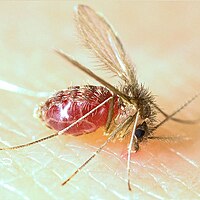
Photo from wikipedia
Background Immunity to the sand fly salivary protein SALO (Salivary Anticomplement of Lutzomyia longipalpis) protected hamsters against Leishmania infantum and L. braziliensis infection and, more recently, a vaccine combination of… Click to show full abstract
Background Immunity to the sand fly salivary protein SALO (Salivary Anticomplement of Lutzomyia longipalpis) protected hamsters against Leishmania infantum and L. braziliensis infection and, more recently, a vaccine combination of a genetically modified Leishmania with SALO conferred strong protection against L. donovani infection. Because of the importance of SALO as a potential component of a leishmaniasis vaccine, a plan to produce this recombinant protein for future scale manufacturing as well as knowledge of its structural characteristics are needed to move SALO forward for the clinical path. Methodology/Principal findings Recombinant SALO was expressed as a soluble secreted protein using Pichia pastoris, rSALO(P), with yields of 1g/L and >99% purity as assessed by SEC-MALS and SDS-PAGE. Unlike its native counterpart, rSALO(P) does not inhibit the classical pathway of complement; however, antibodies to rSALO(P) inhibit the anti-complement activity of sand fly salivary gland homogenate. Immunization with rSALO(P) produces a delayed type hypersensitivity response in C57BL/6 mice, suggesting rSALO(P) lacked anti-complement activity but retained its immunogenicity. The structure of rSALO(P) was solved by S-SAD at Cu-Kalpha to 1.94 Å and refined to Rfactor 17%. SALO is ~80% helical, has no appreciable structural similarities to any human protein, and has limited structural similarity in the C-terminus to members of insect odorant binding proteins. SALO has three predicted human CD4+ T cell epitopes on surface exposed helices. Conclusions/Significance The results indicate that SALO as expressed and purified from P. pastoris is suitable for further scale-up, manufacturing, and testing. SALO has a novel structure, is not similar to any human proteins, is immunogenic in rodents, and does not have the anti-complement activity observed in the native salivary protein which are all important attributes to move this vaccine candidate forward to the clinical path.
Journal Title: PLoS Neglected Tropical Diseases
Year Published: 2017
Link to full text (if available)
Share on Social Media: Sign Up to like & get
recommendations!